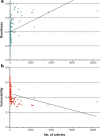Climate change: Does international research fulfill global demands and necessities?
- PMID: 33078088
- PMCID: PMC7558256
- DOI: 10.1186/s12302-020-00419-1
Climate change: Does international research fulfill global demands and necessities?
Abstract
Background: Climate change is safe to be one of the biggest challenges of mankind. Human activities, especially the combustion of fossil fuels, contribute to the increase of greenhouse gases in the atmosphere and thus to the pace of climate change. The effects of climate change are already being felt, and the resulting damage will most likely be enormous worldwide. Because global impacts vary widely and will lead to very different national vulnerability to climate impacts, each country, depending on its economic background, has different options to ward off negative impacts. Decisions have to be made to mitigate climate consequences according to the preparedness and the vulnerability of countries against the presumed impacts. This requires a profound scientific basis. To provide sound background information, a bibliometric study was conducted to present global research on climate change using established and specific parameters. Bibliometric standard parameters, established socioeconomic values, and climate change specific indices were used for the analyses. This allowed us to provide an overall picture of the global research pattern not only in terms of general aspects, but also in terms of climate change impacts, its effects and regional differences. For this purpose, we choose representative indices, such as the CO2 emissions for the responsibility of countries, the global climate risk index as a combination value for the different types of damage that countries can expect, the increase in sea level as a specific parameter as a measure of the huge global environmental impacts, and the readiness and vulnerability index for the different circumstances of individual countries under which climate change will take place. We hope to have thus made a comprehensive and representative selection of specific parameters that is sufficient to map the global research landscape. We have supplemented the methodology accordingly.
Results: In terms of absolute publication numbers, the USA was the leading country, followed by the UK, and China in 3rd place. The steep rise in Chinese publication numbers over time came into view, while their citation numbers are relatively low. Scandinavian countries were leading regarding their publication numbers related to CO2 emission and socioeconomic indices. Only three developing countries stand out in all analyses: Costa Rica, the Fiji Atoll, and Zimbabwe, although it is here that the climate impact will be greatest. A positive correlation between countries' preparedness for the impacts of climate change and their publication numbers could be shown, while the correlation between countries' vulnerability and their publication numbers was negative.
Conclusions: We could show that there exists an inequity between national research efforts according to the publication output and the demands and necessities of countries related to their socioeconomic status. This inequity calls for a rethink, a different approach, and a different policy to improve countries' preparedness and mitigation capacity, which requires the inclusion of the most affected regions of the world in a strengthened international cooperation network.
Keywords: Bibliometrics; Climate inequity; Global warming; Greenhouse effect; Research investment; Socioeconomic indices.
© The Author(s) 2020.
Conflict of interest statement
Competing interestsAll authors declare that they have no competing interests.
Figures










References
-
- Aleixandre-Tudo JL, Bolanos-Pizarro M, Aleixandre JL, Aleixandre-Benavent R. Current trends in scientific research on global warming: a bibliometric analysis. Int J Global Warm. 2019;17:142–169. doi: 10.1504/Ijgw.2019.097858. - DOI
-
- Blunier T, et al. Asynchrony of Antarctic and Greenland climate change during the last glacial period. Nature. 1998;394:739–743. doi: 10.1038/29447. - DOI
-
- Bonacina LCW. Climatic Change and the Retreat of Glaciers. 1 The Self-Generating or Automatic Process in Glaciation. Q J Roy Meteor Soc. 1947;73:85–000. doi: 10.1002/qj.49707331506. - DOI
-
- Brazier A (2015) Konrad Adenauer stiftung, climate change in Zimbabwe, facts for planners and desicion makers. https://www.kas.de/c/document_library/get_file?uuid=6dfce726-fdd1-4f7b-7.... Assessed Mar 2020
LinkOut - more resources
Full Text Sources
